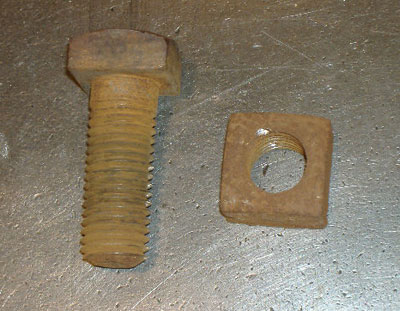 Happy 9-18 Day. The owner of a No. 4T wants to know whether his press has a galley height bed. He mentions that the undercut is .070″ and also wants to know the dimensions of the leveler’s feet, one of which is apparently missing.
Happy 9-18 Day. The owner of a No. 4T wants to know whether his press has a galley height bed. He mentions that the undercut is .070″ and also wants to know the dimensions of the leveler’s feet, one of which is apparently missing.
The simplest way to find out the height-to-paper of the press bed is to place a metal type sort on the bed against the bed bearer. If the face of the sort is level with the bearer then the press has either a .918″ height-to-paper bed or it is a .968″ bed with a .050″ galley plate in place. This method will also work to calibrate an adjustable bed press when the gauge is misaligned or otherwise damaged (e.g. Universal I).
The 4T was designed to pull transparency proofs in addition to standard repro proofs. It is my understanding that all of them have .070″ cylinder undercuts.
The leveler feet, are simply large bolts fitted into the feet of the press and are only necessary when a press is installed on an uneven floor. The bolt is 3/4-10, meaning the diameter is 3/4″ and the thread pitch is 10 to the inch. The length is 2″ (excluding the head). A suitable bolt can be purchased at a hardware store, but the head and nut will have six sides instead of four.-PM

Just to add my two cents, my 4T cylinder is undercut to .070″ as are the other 4T’s at the Wells Book Arts Center. A bit off topic, but I’m curious why a Uni I manual at the Center would have been undercut to .160″? That’s got to be some sort of record depth, but controling that much packing (near 8 sheets of .020″ hard packing) is a headache. (Question to Paul, should that last statement have been submitted in another fashion, a separate entry, a branch? I have little training in blog etiqutte.)
Per Vandercook print M-192, the #4 leveling bolts are as stated earlier by Paul–“.750-10 x 2.000 American Std. Req. Square Hd. Bolt and Std. Square Nut.” But, it says 2 required. There was a nut on the bottom side and the second on top of the bolt where it goes through the hole in leg MN-114. That’s for the front leg. The back legs are part MN-115, and that is a big casting, but there are 2 holes but they are not threaded, and none of the several prints I just looked at to indicate that these were ever threaded. So, my assumption is that leveling was accomplished using only the 2 front bolts, and if anything was required on the left end of the press, then shims would be used. The #4 is built like a battleship–the plans for just the cabinet are overwhelming–no wonder they opted for the replacement press, the SP-15, to be as simple as they could make it, and the word “precision” was an after thought.
Thorough, as always, Eric. To view a complete model 4T with the smoothing roller see https://vandercookpress.info/models.html
Hi, V-folk. That .070″ undercut is likely to allow for a rubber blanket. The 4T, if used for transparent repro work as originally intended, would have had a rubber top-blanket. (The idea was to pull an impression on the blanket itself, then pull an impression on a very thin piece of proofing acetate, printing both sides in register and giving a double density of ink. But the stock was hard to feed and required a special smoothing roller. Most of those rollers have been discarded and 4Ts are pretty much 4s.
My 325G also has a .070″ undercut, but I think that would have allowed for an underblanket. For general proofing work, it lasts longer than tympan packing.
–Eric Holub, SF
Thanks for the great info.
The press bed measurement using the type sort proved my 4T has a .918 bed. The leveler feet were another matter: the front (foot of bed) two are indeed 3/4 x 10 tpi, but the other two, at the feedboard end, are smaller. The hole calipers to 3/8 inch and the thread pitch cannot be determined. A 3/8 bolt goes through the threaded hole in the press foot, but a 7/16 will not. The 3/8 diameter bolt does not engage the threads in the foot. Any ideas? Thanks for any help.
Paul brought up an interesting point about the cylinder undercut on the 4T being .070. A quick check of press cards on about 100 4Ts doesn’t indicate cylinder undercut, but does mention where press beds were other than type high, and those were all export presses to Europe. Standard cylinder undercut on Vandercooks is .040, so I’ll pull some prints to see if the 4T indeed was a uniform .070.
What it means for today’s printer is that packing should have as few pieces as possible by using things like .016 press packing or pressboard that is also .016, sometimes thicker, Good hard packing, that is desireable for most work, is compromised by the use of too many sheets that cause a springy packing.
The first 4T was shipped in 1938, the last in 1957.